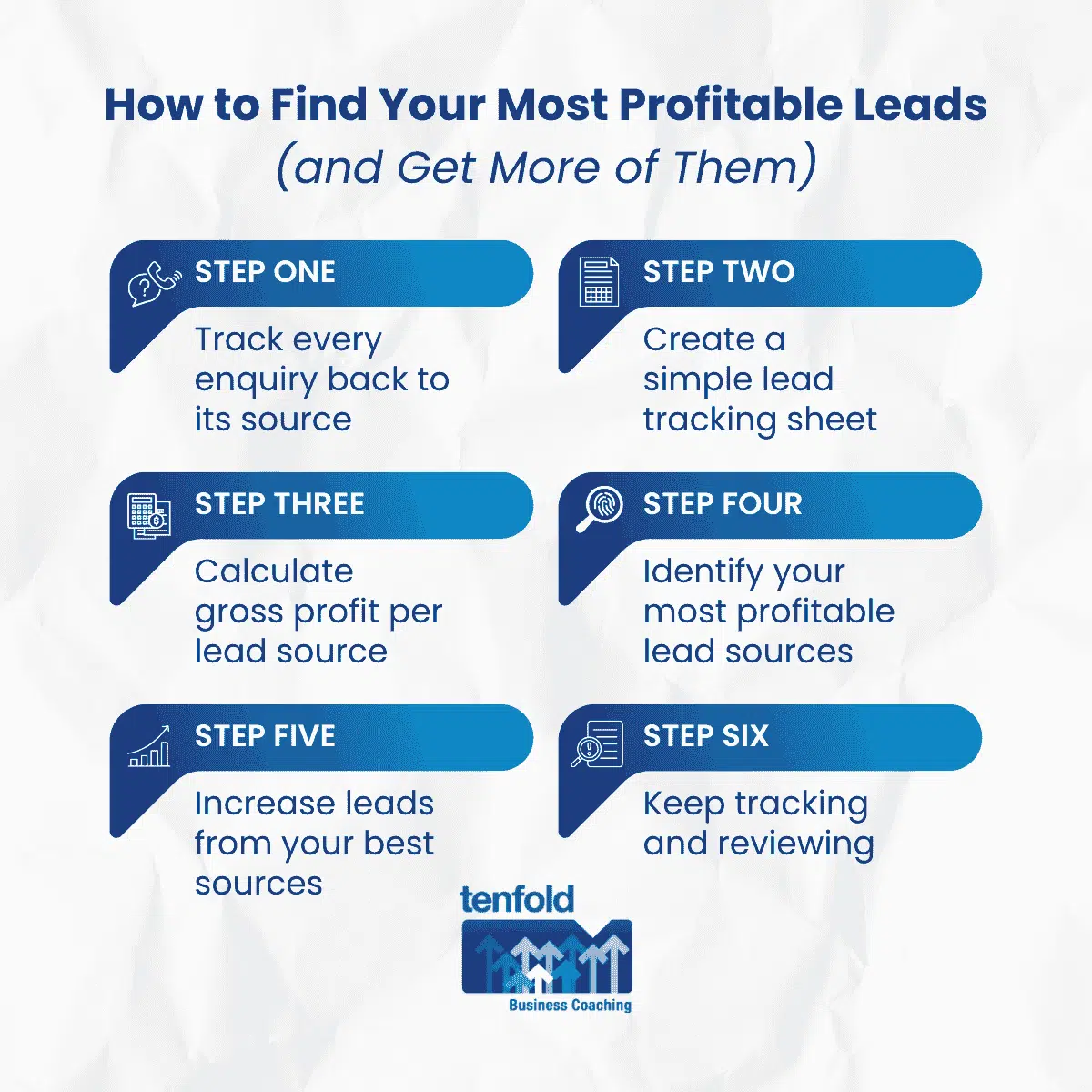How to Find Your Most Profitable Leads (and Get More of Them): A Guide for Trade Business Owners
If you run an established trade business, you already know that not all leads are created equal. Some customers buy quickly, pay well, and don’t haggle. Others drain your time, cut corners, and leave barely any margin.
The difference often isn’t in the work itself, but in where those leads came from. Understanding which marketing channels generate your best jobs — and then doubling down on those — can transform your business from busy to highly profitable.
As a tradie business coach, I’ve helped hundreds of trade business owners across Australia uncover which lead sources deliver the highest returns. In this guide, I’ll show you how to track your leads, measure profit by source, and focus your marketing on what truly works.
Step 1: Track Every Enquiry Back to Its Source
The first step in improving marketing for trades is knowing precisely where your leads come from. You don’t need fancy systems to do it. You can start with a simple spreadsheet and some good habits across your team.
For most trade businesses, enquiries arrive through three main channels: phone calls, website forms, and social media messages such as Instagram DMs. Some also get enquiries from paid ads, email campaigns, or repeat clients. Whatever the mix, the key is to capture that source information from the very first contact.
When a call or message comes in, make sure your office admin or whoever answers asks a simple question: “How did you hear about us?” Then record the answer immediately in a shared log. If you get web enquiries, include a dropdown on your form that asks the same question. The idea is to collect consistent data that you can later analyse.
Many trades rely on their memory or rough estimates, but accuracy here is everything. Without it, you’re flying blind. Even if you don’t have a CRM for contractors in place yet, a spreadsheet can serve as your basic lead tracking system until you’re ready to upgrade.
Step 2: Create a Simple Lead Tracking Sheet
Once you’re capturing enquiry data, the next step is to organise it. Here’s a simple way to set up your lead tracking for trades:
| Enquiry Source | No. of Leads | Jobs Won | Avg. Profit per Job | Total Profit |
| Website | 25 | 10 | $2,200 | $22,000 |
| Google Ads | 15 | 6 | $3,000 | $18,000 |
| Instagram DM | 10 | 3 | $1,000 | $3,000 |
| Referral | 8 | 5 | $3,500 | $17,500 |
This table makes it easy to see which channels are driving your revenue and profit, not just your enquiry numbers.
If your plumbing business, for example, gets 25 leads through the website and only 10 from referrals, your first instinct might be to boost web traffic. But if referrals bring in higher-value commercial maintenance jobs while website leads are mostly low-margin residential quotes, then referrals are your gold mine.
That’s why counting leads isn’t enough. You need to connect each one to the profit it ultimately delivers.
Step 3: Calculate Gross Profit per Lead Source
Profit per lead source is the real measure of marketing ROI for tradies. The goal isn’t to get the most leads, but to get the most profitable ones.
Here’s a simple way to calculate it:
- Work out the average gross profit per job for each source. Gross profit is your revenue minus the direct costs of materials and labour.
- Multiply that by the number of jobs won from that source.
- Compare the totals across your channels.
For example, let’s say your electrical contracting business wins six jobs through Google Ads. Each job averages $3,000 in gross profit. That’s $18,000 total profit from that channel. If your website brings in ten jobs but at a lower profit of $2,200 each, that’s $22,000 total profit. Despite fewer wins, both sources are strong contributors.
On the other hand, if Instagram DMs produce small one-off repairs with lower margins, you might realise it’s not worth the time and ad spend to chase those leads.
Once you’ve done these calculations, you’ll have a clear picture of which channels are delivering real financial results, not just activity.
Step 4: Identify Your Most Profitable Lead Sources
After tracking for a few months, patterns will start to appear. Certain sources will consistently produce high-value, easy-to-convert leads. Others will deliver volume but low margins.
For many trade businesses, referrals often rank highest in profitability. These leads usually come pre-qualified and already trust your brand. Next might be organic website enquiries from builders or property managers who’ve seen your work. Paid ads can perform well, too, but their return depends on how well your ad targeting matches your ideal client.
When you look at your data, ask yourself:
- Which sources generate jobs I actually want more of?
- Which ones bring in clients who value quality and reliability over price?
- Where do my best long-term relationships come from?
This analysis isn’t about cutting off lower sources entirely. It’s about recognising which ones give you the best return on effort and doubling down on them.
Step 5: Increase Leads from Your Best Sources
Once you know which channels bring in your most profitable work, the next step is to amplify them. Here’s how trade business coaching often helps clients do that in practical ways.
Strengthen referral systems
If referrals are your strongest source, make it easy and rewarding for people to refer you. Send follow-up messages thanking clients for recommending your business. Let builders, property managers, or suppliers know you appreciate their trust and are open to more work. Some trade businesses use small gestures, such as gift cards or handwritten notes, to encourage repeat referrals.
Optimise your website for high-value enquiries
If your website generates good leads, improve its clarity and flow. Make sure the pages speak directly to your ideal clients; for instance, property managers or homeowners looking for reliable electrical maintenance. Include clear proof of expertise, before-and-after photos, and testimonials from the kind of jobs you want more of.
You don’t necessarily need more traffic; you need better conversion. Focus on the messaging that attracts your most profitable clients, not just anyone needing a quick quote.
Focus your paid advertising
If Google Ads or Meta Ads deliver results, refine your campaigns to focus on the services and locations that yield the best profit. For example, an HVAC business might find that targeting “commercial split system maintenance Melbourne” leads to far better jobs than general “aircon repair” searches. Use your data to spend smarter, not bigger.
Nurture your social media community
Even if social media isn’t your top profit source, it can still play an important supporting role. Share your most successful projects and client feedback to reinforce credibility. Use your content to attract more of the clients who value your professionalism and service quality.
By aligning your marketing efforts with the data, you’ll waste less on low-margin leads and build a pipeline full of profitable work.
Step 6: Keep Tracking and Reviewing
The most successful trade business owners treat lead tracking as an ongoing discipline. Market conditions change, advertising performance fluctuates, and client types evolve.
Make it a habit to review your lead data monthly. Update your sheet with new enquiries, completed jobs, and profits. Over time, you’ll notice shifts. Perhaps your website’s conversion rate improves after you update your service pages, or your referral numbers spike after you run a customer appreciation campaign.
If you’re using a CRM for contractors, you can automate parts of this tracking. But even manual systems work well if used consistently. The key is discipline and curiosity – asking “What’s working best right now?” and adjusting based on the numbers.
Why This Matters for Growing a Trade Business
Trade business coaching often comes down to helping owners make decisions based on facts, not assumptions. Knowing where your profit comes from gives you leverage. You can focus your marketing spend where it matters, price your work more confidently, and plan growth backed by data.
For example, one Tenfold client (a solar installation company) discovered that property manager referrals generated jobs that yielded 40% more profit than those from Facebook ads. By shifting their attention and marketing budget toward that channel, they increased their gross profit by over $100,000 within six months without taking on extra staff.
That’s the power of knowing your numbers. It turns guesswork into strategy.
Ready to grow your trade business?
If you’re ready to uncover where your most profitable leads come from and scale your business with expert guidance, get in touch with Tenfold Business Coaching. Our experienced team of coaches work with established trade businesses across Australia to improve marketing ROI, increase profit, and build smarter growth strategies.
Learn how tradie business coaching can help you take the next step. Contact us to start the conversation.
FAQs
How long should I track leads before reviewing results?
Start with a three-month window. That’s usually enough to see initial trends. After six months, you’ll have a solid data set to make confident decisions.
What if most of my leads say, “I just found you online”?
Ask a follow-up question like “Was that through Google, Facebook, or our website?” The more specific your data, the more accurate your insights.
Can I do this without a CRM?
Yes. A simple spreadsheet works fine to start. As your business grows, consider upgrading to a contractor CRM to automate follow-ups and reporting.
How often should I update my lead tracking sheet?
Ideally every week. It’s easier to keep up with small updates than to backfill months of missing information.
What’s the biggest mistake trade businesses make with lead tracking?
Treating it as an afterthought. Many owners track revenue but not profitability by source. The goal isn’t just to be busy, it’s to be profitable.




![Account-Based Marketing (ABM) for Contractors: Connect with Facilities & Property Managers [Template, Examples, Checklist]](https://tenfoldcoaching.com.au/wp-content/uploads/2025/09/Account-Based-Marketing-ABM-for-Contractors-Connect-with-Facilities-Property-Managers-Template-Examples-Checklist-500x383.png)

